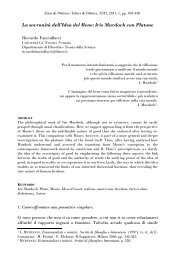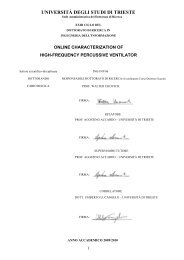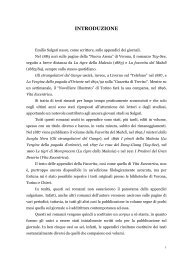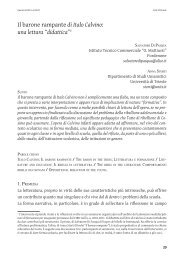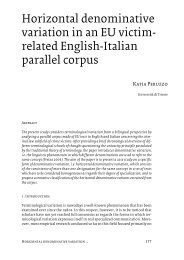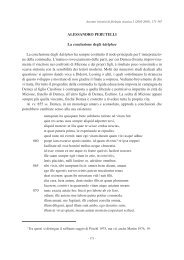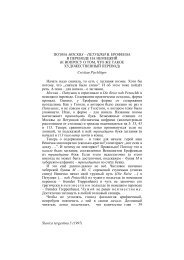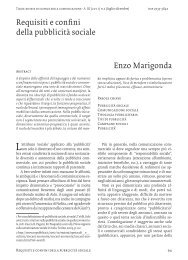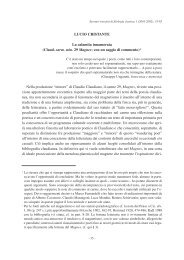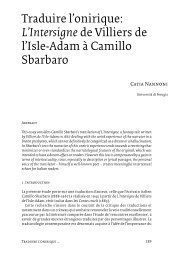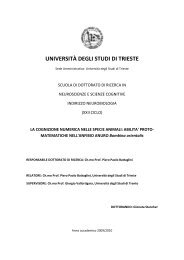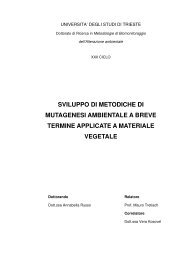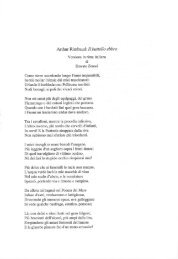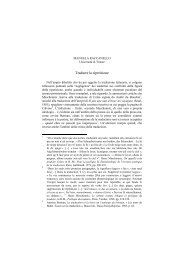tesi dottorato fabbro.pdf - OpenstarTs - Università degli Studi di Trieste
tesi dottorato fabbro.pdf - OpenstarTs - Università degli Studi di Trieste
tesi dottorato fabbro.pdf - OpenstarTs - Università degli Studi di Trieste
Create successful ePaper yourself
Turn your PDF publications into a flip-book with our unique Google optimized e-Paper software.
65 Van de Wal Y, Kooy Y, Van Veelen P, Vader W, Koning F, Pena S Coeliac <strong>di</strong>sease: it takes to three<br />
to tango!. Gut 46 (7): 734-737 ,2000<br />
66 Greco L, Romano R, Coto I et al The first large population based twin study of coeliac <strong>di</strong>sease. Gut<br />
50 (5): 624-628 ,2002<br />
67 King A L, Moo<strong>di</strong>e S J, Fraser J S, Curtis D, Reid E, Dearlove A M, Ellis H J, Ciclitira P J CTLA-<br />
4/CD28 gene region is associated with genetic susceptibility to coeliac <strong>di</strong>sease in UK families. J<br />
Med Genet 39 (1): 51-54 ,2002 68 Greco L, Babron M C, Corazza G R et al Existence of a genetic<br />
risk factor on chromosome 5q in Italian coeliac <strong>di</strong>sease families. Ann Hum Genet 65 (Pt1): 35-<br />
41,2001<br />
69 Clot F, Babron MC. Genetics of celiac <strong>di</strong>sease. Molec Genet Metabol 2000;71:76-80.<br />
70 Zhong F, McCombs CC, Olson JM, Elston RC, Stevens FM, McCarthy CF, Michalsky JP. An<br />
autosomal screen for genes that pre<strong>di</strong>spose to celiac <strong>di</strong>sease in the western countries of Ireland.<br />
Nat Genet 1996;14:329-333.<br />
71 Houlston RS, Tomlinson IP, Ford D, Seal S, Marossy AM, Ferguson A, Holmes GK, Hosie KB,<br />
Howdle PD, Jewell DP, Godkin A, Kerr GD, Kumar P, Logan RF, Love AH, Johnston S, Marsh MN,<br />
Mitton S, O’Donoghue D, Roberts A, Walker-Smith JA, Stratton MF. Linkage analysis of can<strong>di</strong>date<br />
regions for coeliac <strong>di</strong>sease genes. Hum Mol Genet 1997;6:1335-1339.<br />
72 Babron MC, Truy F, Eichenbaum-Voline S, Clerget-Darpoux F. Behavior of the maximum<br />
likelihood score when many affected sibpairs are issued from a few untyped patients. Genet<br />
Epidemiol 1997;14:518,A4.<br />
73 Greco L, Corazza GR, Clot F, Babron MC, Fulchignoni-Lataud MC, Percopo S, Zavattari P,<br />
Bouguerra F, Dib C, Tosi R, Troncone R, Ventura A, Mantovani W, Magazzù G, Gatti R, Lazzari R,<br />
Giunta A, Perri F, Iacono G, Car<strong>di</strong> E, De Virgiliis S, Cataldo F, De Angelis G, Musumeci S, Ferrari<br />
L, Balli F, Bardella MT, Volta U, Catassi C, Torre G, Eliaou JF, Serre JL, Clerget-Darpoux F.<br />
Genome search in coeliac <strong>di</strong>sease. Am J Hum Genet 1998;62:669-675.<br />
74 Djilali-Saiah I, Schmitz J, Harfouch-Hammoud E, Mougenot JF, Bach JF, Caillat-Zucman S. CTLA-4<br />
gene polymorphism is associated with pre<strong>di</strong>sposition to coeliac <strong>di</strong>sease. Gut 1998;43:187-189.<br />
75. Torinsson Naluai Å, Nilsson S, Samuelsson L, Gudjonsdottir AH, Ascher, Ek J, Hallberg B,<br />
Kristiansson B, Martinsson T, Nerman O, Sollid LM, Wahlström J. The CTLA4/CD28 gene region<br />
on chromosome 2q33 confers susceptibility to celiac <strong>di</strong>sease in a way possibly <strong>di</strong>stinct from that<br />
of type I <strong>di</strong>abetes and other chronic inflammatory <strong>di</strong>sorders. Tissue Antigens 2000;56:350-355.<br />
76. Holopainen P, Arvas M, Sistonen P, Mustalahti K, Collin P, Maki M, Partanen J. CD28/CTLA4 gene<br />
region on chromosome 2q33 confers genetic susceptibility to celiac <strong>di</strong>sease. A linkage and<br />
family-based association study. Tissue Antigens 1999;53:470-475.<br />
91



